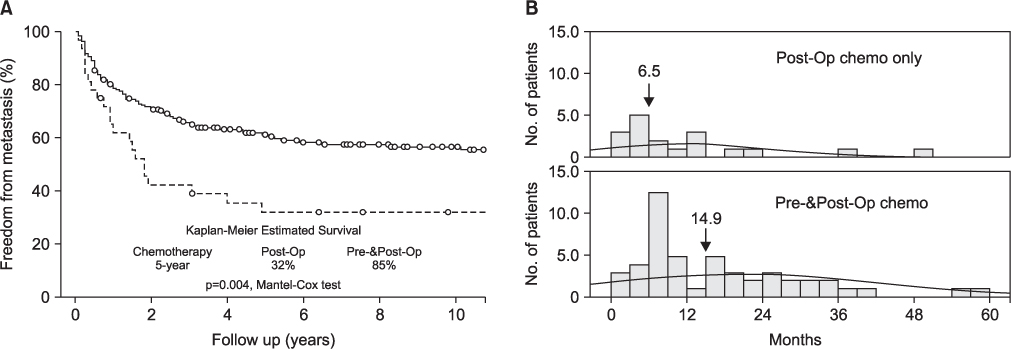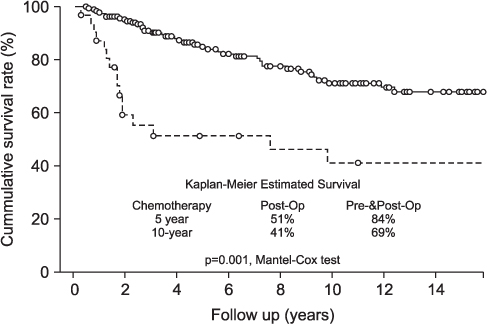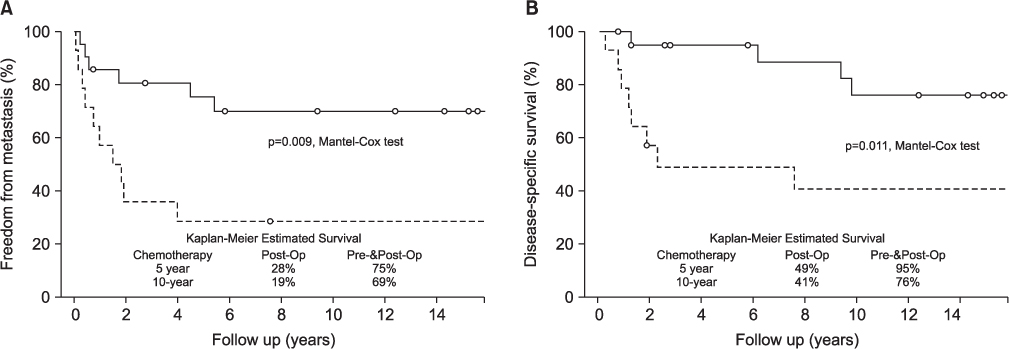J Korean Bone Joint Tumor Soc.
2012 Dec;18(2):59-65. 10.5292/jkbjts.2012.18.2.59.
Effect of Preoperative Chemotherapy on Survival in High-grade Localized Osteosarcoma of the Extremity
- Affiliations
-
- 1Department of Orthopaedic Surgery, Seoul National University College of Medicine, Seoul, Korea. hankim@snu.ac.kr
- KMID: 1431671
- DOI: http://doi.org/10.5292/jkbjts.2012.18.2.59
Abstract
- PURPOSE
Multidisciplinary approaches of surgical resection and chemotherapy have been widely used for the treatment of non-metastatic osteosarcomas. We aimed to assess the effect of neoadjuvant chemotherapy for metastasis and disease-specific survival.
MATERIALS AND METHODS
Authors retrospectively reviewed 225 young (<30 years old) and non-metastatic osteosarcoma patients who underwent surgical resection and postoperative chemotherapy between February 1984 and July 2010. Mean age was 14.4 years old (ranged: 4-29 years old) and average follow-up period was 9.1 years (2-28 years). The patients were divided into two groups according to the application of preoperative chemotherapy. Both groups were compared with clinical characteristics, metastasis-free survival and disease-specific survival.
RESULTS
All of 225 patients, 32 patients were treated with postoperative chemotherapy and 193 patients were performed preoperative and postoperative chemotherapy. Postoperative chemotherapy group showed significantly high rate of amputation (p<0.001). Metastasis was occurred in 101 patients. Postoperative chemotherapy group indicated significant higher rate of metastasis (69% vs 41%, p=0.004) and early development of metastasis (mean: 11.5 vs 20.3 months, p=0.045) than pre-and postoperative chemotherapy group. Fifty-seven patients were died of osteosarcoma. Postoperative chemotherapy group revealed significant lower rate of 5-year disease-specific survival than pre-and postoperative chemotherapy group (51% vs 84%, p=0.001). Adult (>15 years) and large sized tumor (>8 cm) were meaningful risk factors of metastasis and disease-specific survival. Although, local recurrences were occurred in 13 patients, there was no significant difference.
CONCLUSION
Neoadjuvant chemotherapy offers better disease-specific survival and metastasis-free survival.
MeSH Terms
Figure
Reference
-
1. Ritter J, Bielack SS. Osteosarcoma. Ann Oncol. 2010. 21:Suppl 7. vii320–vii325.2. Eilber F, Giuliano A, Eckardt J, Patterson K, Moseley S, Goodnight J. Adjuvant chemotherapy for osteosarcoma: a randomized prospective trial. J Clin Oncol. 1987. 5:21–26.3. Goorin AM, Schwartzentruber DJ, Devidas M, et al. Pediatric Oncology Group. Presurgical chemotherapy compared with immediate surgery and adjuvant chemotherapy for nonmetastatic osteosarcoma: Pediatric Oncology Group Study POG-8651. J Clin Oncol. 2003. 21:1574–1580.4. Bielack SS, Machatschek JN, Flege S, Jürgens H. Delaying surgery with chemotherapy for osteosarcoma of the extremities. Expert Opin Pharmacother. 2004. 5:1243–1256.5. Arndt CA, Crist WM. Common musculoskeletal tumors of childhood and adolescence. N Engl J Med. 1999. 341:342–352.6. Rosen G. Preoperative (neoadjuvant) chemotherapy for osteogenic sarcoma: a ten year experience. Orthopedics. 1985. 8:659–664.7. Goldie JH. Scientific basis for adjuvant and primary (neoadjuvant) chemotherapy. Semin Oncol. 1987. 14:1–7.8. Rosen G, Marcove RC, Caparros B, Nirenberg A, Kosloff C, Huvos AG. Primary osteogenic sarcoma: the rationale for preoperative chemotherapy and delayed surgery. Cancer. 1979. 43:2163–2177.9. Meyers PA, Heller G, Healey J, et al. Chemotherapy for nonmetastatic osteogenic sarcoma: the Memorial Sloan-Kettering experience. J Clin Oncol. 1992. 10:5–15.10. Bielack SS, Kempf-Bielack B, Delling G, et al. Prognostic factors in high-grade osteosarcoma of the extremities or trunk: an analysis of 1,702 patients treated on neoadjuvant cooperative osteosarcoma study group protocols. J Clin Oncol. 2002. 20:776–790.11. Bielack S, Jürgens H, Jundt G, et al. Osteosarcoma: the COSS experience. Cancer Treat Res. 2009. 152:289–308.
- Full Text Links
- Actions
-
Cited
- CITED
-
- Close
- Share
- Similar articles
-
- Osteosarcoma in Korean children and adolescents
- A Case of Osteosarcoma in Maxilla
- Pathological responses to preoperative high-dose methotrexate chemotherapy in osteosarcoma: experience in Korea cancer hospital
- Effects of preoperative cisplatin and adriamycin chemotherapy for non-metastatic osteosarcoma
- Osteosarcoma arising on the surface of long bones: a review of radiologic and histologic spectrum in 9 cases




